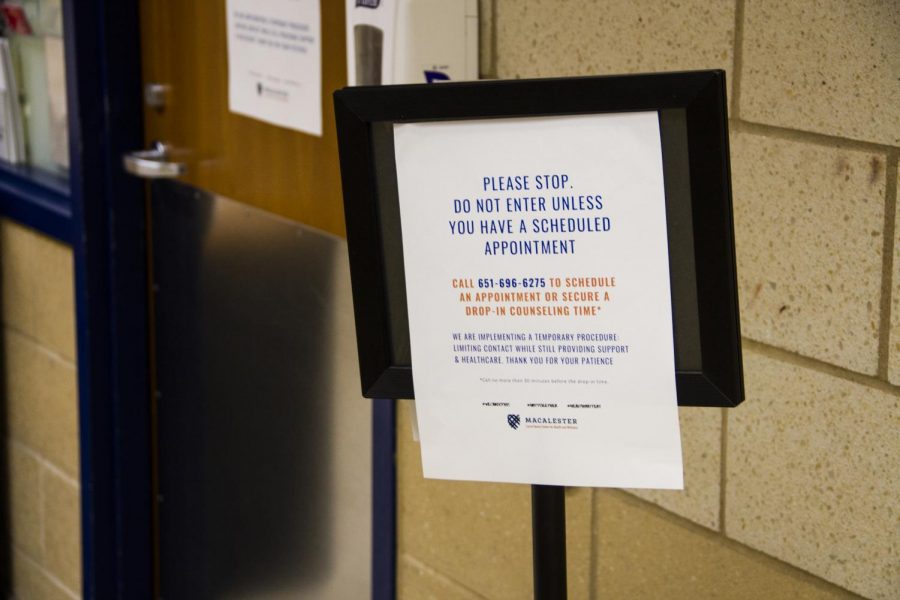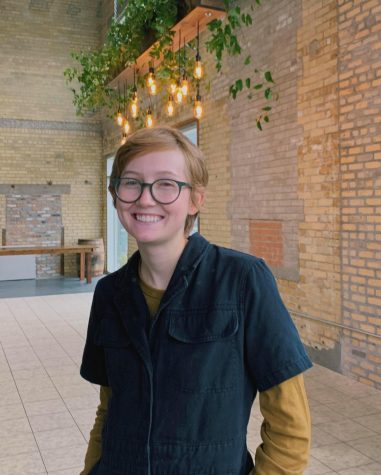Faculty and students prepare to move classes online
March 12, 2020
In a campus-wide email on Wednesday March 11, President Brian Rosenberg announced that the college is cancelling classes for a week following spring break. Rosenberg wrote that the additional time off will allow faculty time to prepare for remote learning scenarios, should the college have to move to an online-only model because of concerns about the transmission of the COVID-19 virus.
“At this point, given the rapidly evolving course of action at colleges and universities across the country, we have asked faculty to begin to consider how they might move instruction to an online format, in the event that we need to cancel in-person classes,” Provost Karine Moe wrote in an email to The Mac Weekly.
Other colleges and universities across the U.S. have made similar moves to online learning, with some sending students home for the remainder of the semester and others allowing them to stay in campus housing and continue to access college and university resources. The University of Minnesota will conduct classes online through April 1, then determine how to proceed.
“Should we make the decision to cancel in-person classes, we will have to adjust over a very short time frame,” Moe wrote. “I have encouraged faculty to familiarize themselves with our available technology and to run a test class online, if possible.”
On Friday, Information Technology Services (ITS) updated their webpage to include two sites: Remote Teaching Preparation and Continued Teaching. Both pages provide resources about how to best deploy technology in the event of online-only classes, and how to engage with it from a student perspective.
“The first step in preparedness is to make sure that we have the software needed if we were to move to online portions or fully online,” Vice President of ITS Jenn Haas said. “For us, a lot of that was getting a Zoom Enterprise license which allows for web conferencing that can also be recorded.”
Zoom is a video conferencing software used by many higher education institutions and corporations that can support such conferencing among large numbers of people. The software can be used to record lectures or host them in real time.
As of last month, the college owned 50 Zoom licenses, an increase from just 25 the year prior. Zoom Enterprise — which allows all faculty, staff and students to access the resource — will cost the college $18,000 a year. The license was funded by the ITS contracts budget.
“It’s a really great tool,” Haas said. “[Zoom] really figured out reliability, so it does well in low bandwidth situations. It’s used very regularly in higher ed. Our hope was always to go to enterprise, and this was a push for us to be able to provide licensing across the institution.”
Zoom allows for online engagement that would otherwise be difficult through Moodle or Google Drive. Students can respond in real time, ask questions and break off into small group discussions.
“For us, if we were to get to a point where there would need to be remote teaching, I think engagement is really important,” Haas said. “As much as we can, we’re trying to provide tools and support to help continue that engagement that is so meaningful that happens in person.”
Psychology professor Cari Gillen-O’Neel tested the Zoom software with two classes. Her initial experiences were largely positive, and Gillen-O’Neel believes the transition from holding classes in-person to Zoom will be relatively easy.
“I think most of the things that I plan to do can go exactly the same,” Gillen-O’Neel said. “For Developmental Psychology, for example, the way that I teach is some powerpoint slides, some lecture, then occasionally there’ll be small group discussion.”
Gillen-O’Neel has used Zoom in the past in both her personal and professional lives. Last year, when classes were cancelled in January due to dangerously low temperatures, Gillen-O’Neel used Zoom to record a lecture for her students.
“I also have a kid at home who has asthma, and I have some immune issues,” Gillen-O’Neel said. “I’m not actually, actually afraid for safety but I think I’m probably going to start staying home soon, possibly even if the college doesn’t mandate it to protect my family and my own health.”
ITS is further examining ways to support students who may not otherwise have access to the necessary technology to attend classes through Zoom. One way might be by recycling old computers. The college purchases new laptops every four years, but keeps the retired computers.
“We’ve got a stock of [old] computers and we’re replacing the hard drives on those to get them in better condition to deploy to students,” Haas said. “We’re in touch with [The Office of] Financial Aid to have them help us identify students that may have this need. We will determine if we also need to purchase assets.”
The college is still considering how to accommodate classes that require in-person performance or projects to accomplish learning goals.
“The challenges are going to be things like lab courses, performance-based projects, ceramics classes, where that interaction and the in-person piece to be able to create something is part of that learning process,” Vice Provost and Associate Dean of Faculty Paul Overvoorde said. “I think it’s going to be, for everybody in those settings, a much more challenging thing to think about.”
Ceramics professor Summer Hills-Bonczyk is already thinking about how to hold classes remotely when students likely won’t have access to the necessary materials.
“Artists are really creative, so we’re pretty good at solving problems,” Hills-Bonczyk said. “It actually might be kind of fun to think about how clay functions in our lives, and look at existing clay objects and do some web based discussion based on that.”
Like the college and ITS, Hills-Bonczyk is looking to other professors for advice and inspiration.
“I have been reaching out to ceramics professors at other schools just to get ideas about what they’re doing,” Hills-Bonczyk said. “In art, we talk about how constraints actually create more creativity.”
Even for more traditional learning environments, hosting classes on Zoom will complicate lesson plans and syllabi. Political science professor Paul Dosh successfully tested the software in class, but anticipates challenges.
“We use simulations in some of my classes, and my current simulation models probably wouldn’t translate well to an online format,” Dosh wrote in an email to The Mac Weekly. “If I was going to direct a simulation online, I’d probably innovate a new one that took advantage of the online format, rather than trying to force an in-person simulation into an online format.”
If students are asked to go home, additional problems regarding attendance, time differences within the United States and across the world, as well as access to the internet, may further complicate learning.
Gillen-O’Neel would prefer to host her classes synchronistically — essentially live streaming her classes at a predetermined time, allowing her to answer questions and lead activities — rather than simply recording lectures, therefore having students engage asynchronously.
“The problem would be if the connection is unstable, if people are having trouble getting on at 9:40 when it’s time, [if students have] time zone differences,” Gillen-O’Neel said. “If people go back home and home is on the other side of the world, then we might have to be more flexible.”
Responding to the coronavirus has necessitated creative solutions to complex problems, both around the world and at the college.
“The challenge is again trying to be mindful of how to deliver the best quality product given these very extenuating kinds of circumstances,” Overvoorde said. “There’s, again, some proceeding with caution but also being very mindful about ways to allow for continued learning to happen this semester is an important thing.”














